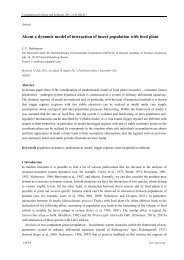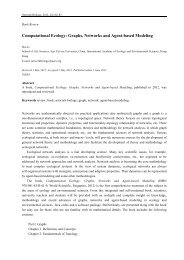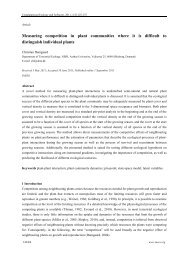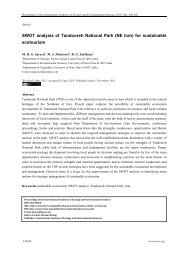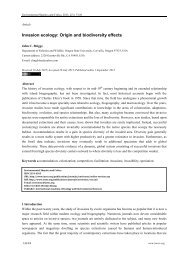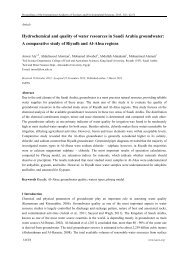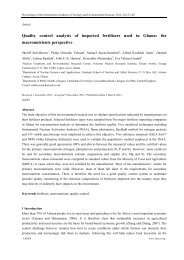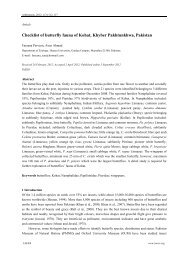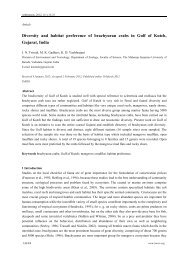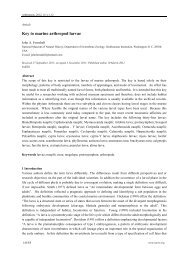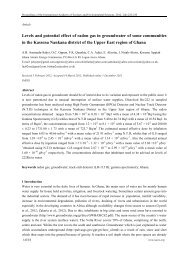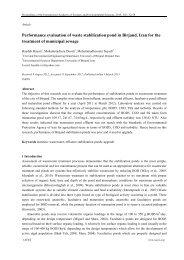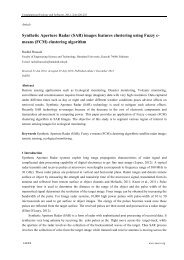Global pesticide consumption and pollution: with China as a focus
Global pesticide consumption and pollution: with China as a focus
Global pesticide consumption and pollution: with China as a focus
You also want an ePaper? Increase the reach of your titles
YUMPU automatically turns print PDFs into web optimized ePapers that Google loves.
139<br />
Proceedings of the International Academy of Ecology <strong>and</strong> Environmental Sciences, 2011, 1(2):125-144<br />
No. samples <strong>with</strong> more than 13 5 3 2 9 2 34<br />
three kinds of <strong>pesticide</strong><br />
residuals<br />
No. samples <strong>with</strong> more than 7 3 3 2 8 2 25<br />
five kinds of <strong>pesticide</strong><br />
residuals<br />
No. samples <strong>with</strong> more than 2 1 0 0 2 0 5<br />
ten kinds of <strong>pesticide</strong><br />
residuals<br />
No. samples containing 1 2 1 1 2 2 9<br />
illegal or high toxic<br />
<strong>pesticide</strong>s<br />
Data from Green Peace (http://www.greenpeace.org/china/zh/)<br />
3.3 Impact of <strong>pesticide</strong>s on human health<br />
The impact of <strong>pesticide</strong>s on human health is divided into two categories, the chronic <strong>and</strong> the acute. Pesticide<br />
poisonings are also divided into productive poisonings, generated in the process of agricultural production, <strong>and</strong><br />
living poisonings, i.e., suicide, ingestion, <strong>and</strong> food intake <strong>with</strong> high-residuals, etc (Liu et al., 2008b).<br />
In <strong>China</strong> young adults from the ages 15 to 59 accounted for 84.11% of the total (Table 16). Most of human<br />
<strong>pesticide</strong> poisonings were living poisonings, of which females accounted for the most proportion. Males made<br />
up the most of productive poisonings (Table 16). Pesticide poisonings occurred mostly in the grain- <strong>and</strong><br />
cotton-producing are<strong>as</strong>, especially cotton-producing are<strong>as</strong>. Human <strong>pesticide</strong> poisonings were mainly from<br />
Sh<strong>and</strong>ong, Jiangsu, Zhejiang <strong>and</strong> Hubei, totally accounted for 66% of the nation’s total.<br />
As can be seen from Table 17, the major <strong>pesticide</strong>s for human poisonings were high-toxic<br />
organophosphorus <strong>pesticide</strong>s, which accounted for 86.02% of the total c<strong>as</strong>es <strong>and</strong> living poisonings made up<br />
97.92%.<br />
Table 16 Age distribution <strong>and</strong> causes of human <strong>pesticide</strong> poisonings during 1997 <strong>and</strong> 2003<br />
Total Productive poisonings Living poisonings<br />
Age C<strong>as</strong>es Deaths % C<strong>as</strong>es Deaths % C<strong>as</strong>es Deaths %<br />
0~ 6291 244 3.88 251 1 0.40 6040 243 4.02<br />
15~ 47447 2641 5.57 9669 77 0.80 37778 2564 6.79<br />
35~ 43710 2823 6.46 15241 84 0.55 28469 2739 9.62<br />
60~ 3951 435 11.01 1236 13 1.05 2715 422 15.54<br />
65~ 2633 390 14.81 627 10 1.59 2006 380 18.94<br />
70~ 4322 903 20.89 482 14 2.90 3840 889 23.15<br />
Unknown 18 1 5.56 5 0 0.00 13 1 7.69<br />
Total 108372 7437 6.86 27511 199 0.72 80861 7238 8.95<br />
IAEES<br />
www.iaees.org



